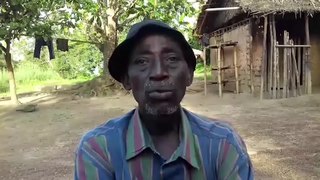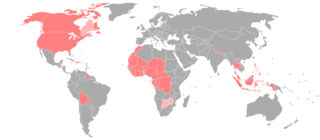Related Research Articles

Low Saxon, also known as West Low German are a group of Low German dialects spoken in parts of the Netherlands, northwestern Germany and southern Denmark. It is one of two dialect groups, the other being East Low German.

Giimbiyu is an extinct Aboriginal Australian language isolate once spoken by the Giimbiyu people of northern Australia.
Maninka, or more precisely Eastern Maninka, is the name of several closely related languages and dialects of the southeastern Manding subgroup of the Mande language family. It is the mother tongue of the Malinké people in Guinea, where it is spoken by 3.1 million people and is the main language in the Upper Guinea region, and in Mali, where the closely related Bambara is a national language, as well as in Liberia, Senegal, Sierra Leone and Ivory Coast, where it has no official status. It was the language of court and government during the Mali Empire.
The Ngbandi language is a dialect continuum of the Ubangian family spoken by a half-million or so people in the Democratic Republic of Congo and in the Central African Republic. It is primarily spoken by the Ngbandi people, which included the dictator of what was then known as Zaire, Mobutu Sese Seko.
Akwáwa is a Tupi–Guarani dialect cluster spoken in Pará in western Brazil.
Sahu is a North Halmahera language. Use is vigorous; dialects are Pa’disua (Palisua), Tala’i, Waioli, and Gamkonora. A fifth dialect, Ibu, used to be spoken near the mouth of the Ibu River.

Maram is a Sino-Tibetan language spoken in India. The speakers of this language use Meitei language as their second language (L2) according to the Ethnologue.

Gangte is a Sino-Tibetan language of Kuki-Chin linguistic sub branch of Northeastern India. Its speakers primarily live in Manipur and the adjacent areas of Meghalaya and Assam. The language appears to be homogeneous with no known dialectal variation and exhibits at least partial mutual intelligibility with the other Chin-Kuki-Mizo dialects of the area including Thadou, Hmar, Vaiphei, Simte, Kom and Paite languages. The speakers of this language use Meitei language as their second language (L2) according to the Ethnologue.
Zemba or Dhimba is a Bantu language spoken mainly in Angola where the language has about 18,000 speakers, and also in Namibia with some 7,000. It is closely related to Herero, and is often considered a dialect of that language, especially as the Zemba are ethnically Herero.

Konobo, or Eastern Krahn, is a Kru language of Liberia.
Central Teke is a member of the Teke languages dialect continuum of the Congolese plateau. Central Teke dialects are Ngungwel and Mpu (Mpumpum), Boo, and Nzikou (Njyunjyu/Ndzindziu). They are spoken in the Malebo Pool region of the Republic of Congo, with an unknown number of Boo speakers in DRC.
Bhilali is a Bhil language of India. Two varieties, Bhilali proper and Rathawi (Rathwi), are largely mutually intelligible. A third, Parya Bhilali, is more distant, but is treated as a dialect.
Alto Pativilca–Alto Marañón–Alto Huallaga Quechua is a dialect cluster of Quechua languages spoken in the Peruvian provinces of Huánuco, Lauricocha, Cajatambo and neighboring areas. The best-known dialect within the Huánuco cluster is Huallaga Quechua.
Mono is a moribund Mbum language spoken by older adults in northern Cameroon.
Lahta, or Zayein, is a Karenic language of Burma.
Rathwi Bareli is a Bhil language of India, spoken mainly in Gujarat. It is close to two other languages called Bareli, but not mutually intelligible with them. It has 81%–93% lexical similarity with Rathwi Bareli dialects, 67%–73% with Palya Bareli and 68%–79% with Pauri Bareli.
Kyirong is a language from the subgroup of Tibetic languages spoken in the Gyirong County of the Shigatse prefecture, of the Tibetan Autonomous Region.
Bote (Bote-Majhi) and Darai are mutually intelligible tribal dialects of Nepal that are close to Danwar Rai and Tharu languages but otherwise unclassified. Its speakers are rapidly shifting to Nepali.

American Sign Language (ASL) developed in the United States, starting as a blend of local sign languages and French Sign Language (FSL). Local varieties have developed in many countries, but there is little research on which should be considered dialects of ASL and which have diverged to the point of being distinct languages.
References
- 1 2 3 Hlepho Phowa at Ethnologue (25th ed., 2022)

Labo Phowa at Ethnologue (25th ed., 2022)
Ani Phowa at Ethnologue (25th ed., 2022)
